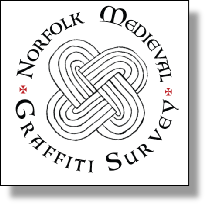










Although at first glance the presence of ship graffiti on the walls of a coastal church may appear straightforward. Local sailors and their families simply sketching what they saw every day. However, the work of the survey nationwide has raised a number of interesting questions that cast some doubt on the simplistic approach. Although many of these ship images are located in coastal churches, with particular concentrations around medieval ports, just as many are to be found inland. Indeed, examples have been recorded as far inland as Leicestershire, where it would be difficult to get any farther from the coast. Despite this all the examples recorded to date all show seagoing vessels rather than river craft.
In addition, surveys in churches such as St Nicholas, Blakeney, and St Thomas’, Winchelsea, all appear to show a very distinct distribution pattern to the graffiti. Rather than being randomly scratched into the walls they appear to concentrate in particular areas of the church. At Blakeney, despite the whole church being covered by early inscriptions, all the ship graffiti appears on the south arcade, clustered around a side altar and an empty image niche. Each respects the other images around it, not covering them over, and archaeologists suggest that they were created over a period of at least two centuries. The suggestion, therefore, is that many of these ship images were in fact devotional in nature. Literally prayers made solid in stone. Exactly what these prayers were for remains something of a mystery. Where they thanks for a voyage safely undertaken, a prayer for a safe voyage yet to come, or perhaps a plea for a ship long overdue? We will probably never know, however it is possible they may be informal versions of votive ships, models which were displayed within churches at the time.
















